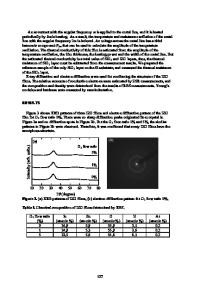Ferromagnetism in Nanocrystalline Powders and Thin Films of Cobalt-Vanadium codoped Zinc Oxide
- PDF / 452,749 Bytes
- 6 Pages / 432 x 648 pts Page_size
- 61 Downloads / 444 Views
Ferromagnetism in Nanocrystalline Powders and Thin Films of Cobalt-Vanadium codoped Zinc Oxide Marco Gálvez-Saldaña1, Gina Montes-Albino2 and Oscar Perales-Perez3 ¹Department of Physics, University of Puerto Rico at Mayagüez, Mayagüez 00980, PR, USA. 2 Department of Mechanical Engineering, University of Puerto Rico at Mayagüez P.O. Box 9045, Mayagüez, PR, 00681-9045 USA. 3 Department of Engineering Science and Materials, University of Puerto Rico at Mayagüez, Mayaguez, PR, 00680-9044, USA. ABSTRACT A systematic study was carried out to determine the effect of the composition and annealing atmosphere (air and N2) on the structural, optical and magnetic properties of pure, doped and codoped ZnO [Zn(1-y)(CoV)yO] nanocrystalline powders and films. The (Co+V) doping level, ‘y’, was fixed at 2 at% with variable individual concentrations of Co and V species. Powders and films were synthesized via a sol-gel approach where the films were grown on silicon (100) substrates. X-ray diffractometry verified the formation of the ZnO host structure after annealing of the precursor phases. The variation of the average crystallite size of Co-V (2 at.%) ZnO powders annealed in air at 500°C were negligible and averaged 33 nm. Photoluminescence (PL) measurements of powder corroborated the formation of high-quality ZnO host structure, as well as in films annealed in air. In turn, XRD and PL measurements confirmed an enhanced crystallinity of the ZnO host, with an average crystallite size of 41 nm, for films annealed at 500°C under a N2 atmosphere. M-H measurements evidenced a ferromagnetic behavior at room temperature in powders and films that was dependent on the type and amount of the dopant species. I. INTRODUCTION ZnO is a II-VI semiconductor type with hexagonal wurtzite structure and belongs to the space group C46V or P63mc. The corresponding hexagonal unit cell has two lattice parameters: ‘a’= 3.249Å and ‘c’=5.207Å [1]. The larger exciton binding energy ~60 meV and wide band gap ~ 3.3 eV at room temperature increase the technological attractiveness of this oxide. In turn, the effective incorporation of dopant species into ZnO host structure usually induces changes in the physical and chemical structure, leading to novel multi-functional properties. In the case of ZnO doped with transition metal ions, the subsequent exchange interaction between available spins of the magnetic species would induce a ferromagnetic behavior in the so-called ZnO-based diluted magnetic semiconductor (DMS) [2,3]. This ferromagnetic functionality would enable the application of this material in data storage and spintronics-based devices. The rationale behind the synthesis of co-doped (Co + V) ZnO relies on the expected synergistic effect of these doping species, based on our earlier work where doping of ZnO with Co or V induced a strong roomtemperature ferromagnetism [4]. In addition, there is a lack of systematic studies regarding the effect of co-doping of ZnO on the corresponding optical and magnetic properties in thin films. There are numerous depositio
Data Loading...











